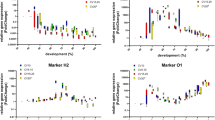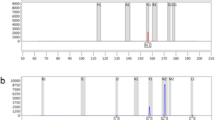Abstract
The estimation of the minimum postmortem interval can be implemented by age estimation of corpse-associated primary colonizers such as the blow flies (Diptera: Calliphoridae). In cases where pupae represent the oldest stages found on a body, their age must be added to the duration of prepupal development to estimate the minimum postmortem interval. Although methods to age blow fly larvae have been well established using morphology, length or weight and age estimation of pupae has proved challenging. In a previous work, we quantified the changes in mRNA levels of four differentially expressed genes during the metamorphosis of Calliphora vicina pupae, hence representing molecular markers for pupal age (i.e., time elapsed since pupariation). Here, we demonstrate how these data can be used to estimate pupal age with inverse prediction. We present three blind studies conducted under various conditions and show that age of C. vicina pupae can be well estimated based on gene expression data. As these data are quantitative and can be processed automatically, gene expression has the potential to outperform morphological analysis in age estimation of forensically relevant blow fly pupae.




Similar content being viewed by others
References
VanLaerhoven SL, Anderson GS (1999) Insect succession on buried carrion in two biogeoclimatic zones of British Columbia. J For Sci 44(1):32–43
Wells JD, LaMotte LR (2009) Estimating the postmortem interval. In: Castner JL, Byrd JH (eds) Forensic entomology - The utility of arthropods in legal investigations, 2nd edn. CRC Press, New York
Amendt J, Richards CS, Campobasso CP, Zehner R, Hall MJ (2011) Forensic entomology: applications and limitations. Forensic Sci Med Pathol 7(4):379–392
Smith KGV (1986) A manual of forensic entomology. London and Cornell University Press, London
Grassberger M, Reiter C (2001) Effect of temperature on Lucilia sericata (Diptera: Calliphoridae) development with special reference to the isomegalen- and isomorphen-diagram. For Sci Int 120(1–2):32–36
Villet M, Amendt J (2011) Advances in entomological methods for death time estimation. In: Turk EE (ed) Forensic Pathology Reviews. Humana Press, Heidelberg
Richards CS, Crous KL, Villet M (2009) Models of development for blowfly sister species Chrysomya chloropyga and Chrysomya putoria. Med Vet Entomol 23(1):56–61
Wells JD, LaMotte LR (1995) Estimating maggot age from weight using inverse prediction. J For Sci 40(4):585–590
Amendt J, Campobasso CP, Gaudry E, Reiter C, LeBlanc HN, Hall MJ, Entomology. EAfF (2007) Best practice in forensic entomology—standards and guidelines. Int J Legal Med 121(2):90–104
Bainbridge SP, Bownes M (1981) Staging the metamorphosis of Drosophila melanogaster. J Embryol Exp Morphol 66:57–80
Robertson CW (1936) The metamorphosis of Drosophila melanogaster, including an accurately timed account of the principal morphological changes. J Morphol 59:351–399
Davies K, Harvey ML (2013) Internal morphological analysis for age estimation of blow fly pupae (Diptera: Calliphoridae) in postmortem interval estimation. J For Sci 58(1):79–84
Zajac BK (2011) Morphologische und histologische Methoden zur Bestimmung des Alters forensisch relevanter Fliegenpuppen. Goethe University, Frankfurt a.M
Boehme P, Spahn P, Amendt J, Zehner R (2013) Differential gene expression during metamorphosis: a promising approach for age estimation of forensically important Calliphora vicina pupae (Diptera: Calliphoridae). Int J Legal Med 127(1):243–249
Tarone AM, Jennings KC, Foran DR (2007) Aging blow fly eggs using gene expression: a feasibility study. J For Sci 52(6):1350–1354
Tarone AM, Picard CJ, Spiegelman C, Foran DR (2011) Population and temperature effects on Lucilia sericata (Diptera: Calliphoridae) body size and minimum development time. J Med Entomol 48(5):1062–1068
Ames C, Turner B, Daniel B (2006) Estimating the post-mortem interval (II): The use of differential temporal gene expression to determine the age of blowfly pupae. Int Congr Ser 1288:795–797
Zehner R, Mösch S, Amendt J (2006) Estimating the postmortem interval by determining the age of fly pupae: are there any molecular tools? Prog For Gen 11:619–621
Buszczak M, Segraves WA (2000) Insect metamorphosis: out with the old, in with the new. Curr Biol 10(22):R830–R833
White KP, Rifkin SA, Hurban P, Hogness DS (1999) Microarray analysis of Drosophila development during metamorphosis. Science 286(5447):2179–2184
Bowen ID, Mullarkey K, Morgan SM (1996) Programmed cell death during metamorphosis in the blow-fly Calliphora vomitoria. Micros Res Tech 34(3):202–217
Higley LG, Haskell NH (2009) Insect development and forensic entomology. In: Byrd JH, Castner JL (eds) Forensic entomology - The utility of arthropods in legal investigations, 2nd edn. CRC Press, New York
R Devlopment Core Team (2010) R: a language and environment for statistical computing. R Foundation for Statistical Computing, Vienna
Tarone AM, Foran DR (2011) Gene expression during blowfly development: improving the precision of age estimates in forensic entomology. J For Sci 56(Suppl 1):S112–S122
Mösch SA (2005) Molekularbiologische Altersbestimmung an Puppen der forensisch relevanten Schmeißfliege Lucilia sericata. Diploma Thesis, Fachhochschule Aachen
Sze SH, Dunham JP, Carey B, Chang PL, Li F, Edman RM, Fjeldsted C, Scott MJ, Nuzhdin SV, Tarone AM (2012) A de novo transcriptome assembly of Lucilia sericata (Diptera: Calliphoridae) with predicted alternative splices, single nucleotide polymorphisms and transcript expression estimates. Insect Mol Biol 21(2):205–221
Donovan SE, Hall MJ, Turner BD, Moncrieff CB (2006) Larval growth rates of the blowfly, Calliphora vicina, over a range of temperatures. Med Vet Entomol 20(1):106–114
Arnott S, Turner B (2008) Post-feeding larval behaviour in the blowfly, Calliphora vicina: effect on post-mortem interval estimates. For Sci Int 177(2–3):162–167
Michaud J-P, Moreau G (2011) A statistical approach based on accumulated degree-days to predict decomposition-related processes in forensic studies. J For Sci 56(1):229–232
Ames C, Turner BD (2003) Low temperature episodes in development of blowflies: implications for postmortem interval estimation. Med Vet Entomol 17(2):178–186
Anderson GS (2000) Minimum and maximum development rates of some forensically important Calliphoridae (Diptera). J For Sci 45(4):824–832
Reibe S, Doetinchem PV, Madea B (2010) A new simulation-based model for calculating post-mortem intervals using developmental data for Lucilia sericata (Dipt.: Calliphoridae). Parasitol Res 107(1):9–16
Brown K, Thorne A, Harvey M (2012) Preservation of Calliphora vicina (Diptera: Calliphoridae) pupae for use in post-mortem interval estimation. For Sci Int 223:176–183
Acknowledgments
The authors thank the anonymous reviewers and Prof. Christine Picard for her very helpful suggestions. Thanks to Dr. Yvonne Kendel and Michèle Baqué for their support in the blind study experiments. This project was financially supported by the Deutsche Forschungsgemeinschaft (project number: ZE 501/2-1).
Author information
Authors and Affiliations
Corresponding author
Additional information
Petra Boehme and Philipp Spahn contributed equally to this work.
Electronic supplementary material
Below is the link to the electronic supplementary material.
ESM 1
(PDF 163 kb)
Rights and permissions
About this article
Cite this article
Boehme, P., Spahn, P., Amendt, J. et al. The analysis of temporal gene expression to estimate the age of forensically important blow fly pupae: results from three blind studies. Int J Legal Med 128, 565–573 (2014). https://doi.org/10.1007/s00414-013-0922-8
Received:
Accepted:
Published:
Issue Date:
DOI: https://doi.org/10.1007/s00414-013-0922-8




